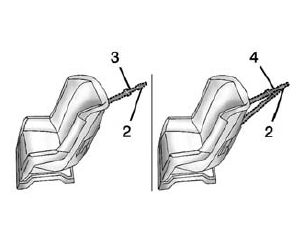Chevrolet Spark Owners Manual: Top Tether Anchor

A top tether (3, 4) anchors the top of the child restraint to the vehicle.
A top tether anchor is built into the vehicle. The top tether attachment (2) on the child restraint connects to the top tether anchor in the vehicle in order to reduce the forward movement and rotation of the child restraint during driving or in a crash.
The child restraint may have a single tether (3) or a dual tether (4).
Either will have a single attachment (2) to secure the top tether to the anchor.
Some child restraints that have a top tether are designed for use with or without the top tether being attached. Others require the top tether always to be attached. In Canada, the law requires that forward-facing child restraints have a top tether, and that the tether be attached. Be sure to read and follow the instructions for your child restraint.
 Lower Anchors
Lower Anchors
Lower anchors (1) are metal bars built into the vehicle. There are two lower
anchors for each LATCH seating position that will accommodate a child restraint
with lower attachments (2). ...
 Lower Anchor and Top Tether Anchor Locations
Lower Anchor and Top Tether Anchor Locations
(Top Tether Anchor): Seating positions
with top tether anchors.
(Lower Anchor): Seating positions
with two lower anchors.
To assist in locating the lower
anchors, each seating position w ...
Other materials:
Torque Lock (Automatic Transmission)
If you are parking on a hill and you do not shift the transmission into P (Park)
properly, the weight of the vehicle may put too much force on the parking pawl in
the transmission. You may find it difficult to pull the shift lever out of P (Park).
This is called “torque lock.” To prevent torque ...
Tire Chains
Warning
Do not use tire chains. There is not enough clearance. Tire chains
used on a vehicle without the proper amount of clearance can cause damage to the
brakes, suspension, or other vehicle parts. The area damaged by the tire chains
could cause loss of control and a crash.
Use another typ ...
Airbag System
The vehicle has the following airbags:
A frontal airbag for the driver.
A frontal airbag for the front outboard passenger.
A knee airbag for the driver.
A knee airbag for the front outboard passenger
A seat-mounted side impact airbag for the driver.
A seat-mounted side impact airbag fo ...
